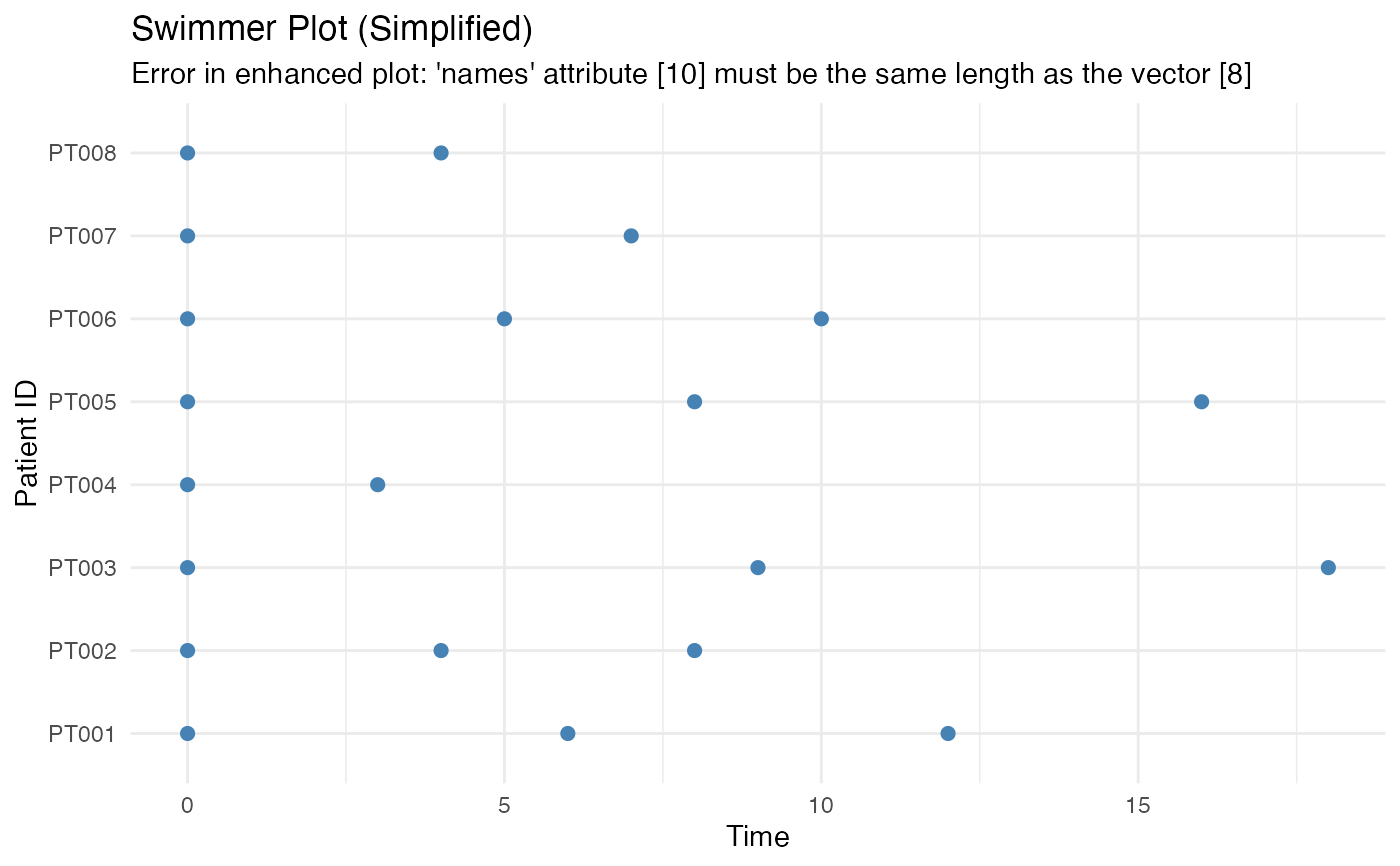Event Markers Swimmer Plot Example Data
Source:R/data_swimmer_unified_docs.R
swimmer_unified_events.RdA longitudinal dataset designed to demonstrate event marker functionality. Shows multiple timeline segments per patient with different clinical events, treatments, and adverse event management.
Usage
data(swimmer_unified_events)Format
A data frame with 20 rows and 8 variables:
- PatientID
Character. Patient identifiers (multiple rows per patient)
- StartTime
Numeric. Segment start time in months
- EndTime
Numeric. Segment end time in months
- Response
Character. Response during this segment (CR, PR, SD, PD)
- EventType
Character. Type of clinical event (Treatment Start, Dose Escalation, etc.)
- EventTime
Numeric. Time when the event occurred
- Severity
Character. Event severity (None, Mild, Moderate, Severe)
- Cycle
Numeric. Treatment cycle number
See also
Other swimmer plot datasets:
swimmer_unified_basic,
swimmer_unified_comprehensive,
swimmer_unified_datetime,
swimmer_unified_oncology
Examples
data(swimmer_unified_events)
# Event markers swimmer plot
swimmerplot(
data = swimmer_unified_events,
patientID = "PatientID",
startTime = "StartTime",
endTime = "EndTime",
responseVar = "Response",
showEventMarkers = TRUE,
eventVar = "EventType",
eventTimeVar = "EventTime",
markerSize = 6,
plotTheme = "ggswim"
)
#>
#> SWIMMER PLOT
#>
#> character(0)
#>
#> Timeline Summary Statistics
#> ────────────────────────────────────
#> Metric Value
#> ────────────────────────────────────
#> Number of Patients 8.000000
#> Total Observations 21.000000
#> Median Duration 6.000000
#> Mean Duration 5.900000
#> Total Person-Time 124.000000
#> Mean Follow-up 15.500000
#> CR Rate (%) 42.900000
#> PD Rate (%) 23.800000
#> PR Rate (%) 19.000000
#> SD Rate (%) 14.300000
#> ────────────────────────────────────
#>
#>
#> <div style='background-color: #e8f5e8; padding: 15px; border-radius:
#> 5px; margin: 10px 0;'>
#>
#> Clinical Interpretation
#>
#> <div style='margin: 10px 0;'><h5 style='color: #2e7d32;'>Timeline
#> Analysis:
#>
#> Study included 8 patients with 21 timeline observations. Median
#> follow-up was 6.0 months (range: 3.0 to 9.0 months).
#>
#> <div style='margin: 10px 0;'><h5 style='color: #2e7d32;'>Person-Time
#> Analysis:
#>
#> Total person-time: 124.0 months. Average follow-up per patient: 15.5
#> months.
#>
#> <div style='margin: 10px 0;'><h5 style='color: #2e7d32;'>Response
#> Pattern Analysis:
#>
#> Most common response was CR (42.9% of observations). Response
#> distribution shows clinical patterns suitable for efficacy analysis.
#>
#> Person-Time Analysis
#> ──────────────────────────────────────────────────────────────────────────
#> Response Type Patients Total Time Mean Time Incidence Rate
#> ──────────────────────────────────────────────────────────────────────────
#> ──────────────────────────────────────────────────────────────────────────
#>
#>
#> Milestone Event Summary
#> ────────────────────────────────────────────────────
#> Milestone Events Median Time Time Range
#> ────────────────────────────────────────────────────
#> ────────────────────────────────────────────────────
#>
#>
#> Event Marker Summary
#> ────────────────────────────────────────────────────
#> Event Type Count Percentage Median Time
#> ────────────────────────────────────────────────────
#> ────────────────────────────────────────────────────
#>
#>
#> Advanced Clinical Metrics
#> ──────────────────────────────────────────────────────
#> Metric Value Unit Clinical Interpretation
#> ──────────────────────────────────────────────────────
#> ──────────────────────────────────────────────────────
#>
